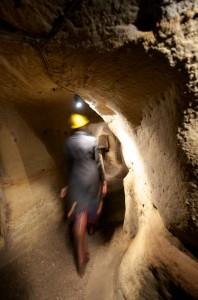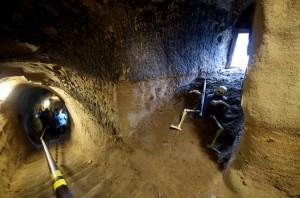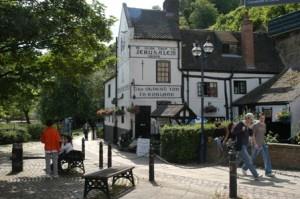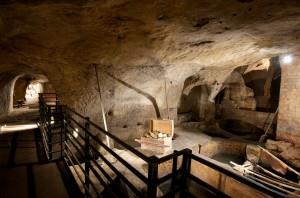In love-local
We caught up with Dr David Strange-Walker from the Nottingham Cave Survey, to delve into Nottingham's hidden world beneath the city streets.
Tell me again, just how many caves are beneath Nottingham?
To date we know of 543 caves, of which about 400 are probably still there. There are probably another hundred or so that we don't know about yet!
How did Nottingham come to have so many caves?
It's because of the geology and the topography. Nottingham is built on sandstone which is very soft, making it easy to excavate, but also surprisingly strong, which means our caves don't collapse. The city is built on cliffs which flank the floodplain of the River Trent, and from the earliest times cave dwellings were cut back into the cliff-face to make houses. Later, in the medieval period and after, people cut caves below their properties to use as cellars. This was an easy way to increase space in your property, and became more important as the population of the town expanded during the industrial revolution, while the physical size of the town remained the same as it was in the medieval.  Over that time people used caves for a huge variety of purposes - houses, dungeons, tunnels, tanneries, malt kilns, pottery kilns, chapels, cemeteries, sand mines, pub cellars, restaurants, butcheries, hermitages, tourist attractions, cold storage, fireproof storage, wine cellars, follies, lounge caves and even cannabis factories.
What is the Nottingham Cave Survey aiming to do?
Our 'mission statement', if you'll excuse the phrase, is to investigate, record, archive, visualise and promote Nottingham's man-made sandstone caves. So we're trying to find 'new', unknown, caves; we're visiting and recording many of the known caves with our 3D laser scanner; we're creating a full GIS database of all knowledge and documentation about the caves; we're producing management strategy and documents for the City's heritage professionals and planners; and we're opening up virtual access to the caves through our website and forthcoming Nottingham Caves smartphone app. In summary we're trying to ensure that the caves will be preserved and protected into the future by showing and telling how interesting and unusual they are. http://nottinghamcavessurvey.org.uk/
Over that time people used caves for a huge variety of purposes - houses, dungeons, tunnels, tanneries, malt kilns, pottery kilns, chapels, cemeteries, sand mines, pub cellars, restaurants, butcheries, hermitages, tourist attractions, cold storage, fireproof storage, wine cellars, follies, lounge caves and even cannabis factories.
What is the Nottingham Cave Survey aiming to do?
Our 'mission statement', if you'll excuse the phrase, is to investigate, record, archive, visualise and promote Nottingham's man-made sandstone caves. So we're trying to find 'new', unknown, caves; we're visiting and recording many of the known caves with our 3D laser scanner; we're creating a full GIS database of all knowledge and documentation about the caves; we're producing management strategy and documents for the City's heritage professionals and planners; and we're opening up virtual access to the caves through our website and forthcoming Nottingham Caves smartphone app. In summary we're trying to ensure that the caves will be preserved and protected into the future by showing and telling how interesting and unusual they are. http://nottinghamcavessurvey.org.uk/
 Do you have a favourite cave?
I have two, quite different. The first is a stand-out medieval gem - Cave BK2, below Birkins' lace warehouse on Broadway (now Propaganda nightclub). This was a medieval malting complex for turning barley into malt for brewing, and has a well, cistern, germination floor and kiln. It has carved crosses on its walls - a good indicator of a medieval cave. The exciting thing is that this is a completely intact medieval industrial complex - without a lot of work you could put this back into use as a malting. Intact medieval industrial facilities basically don't exist in Britain - there are a few medieval mills and the like around the country, like the one at Fountains Abbey, but they have generally been altered significantly. This is a bit of a time capsule, and an outstanding survival.
The second is a small 19th-century cellar cave beneath a house on Newcastle Terrace in the Park estate. Many of the large houses in and around the Park were designed and built by the Victorian architect TC Hine. His earlier houses of the 1840s often have small storage caves beneath them. This particular house, built I think in 1864, has a long cellar cavebeneath it split into two chambers. On the right is a really nicely-tooled wine cellar, with bins and shelves, partitions and alcoves. On the left the chamber is much more roughly hewn, with a bench seat carved on one side, three rustic alcoves on the other, and a smoke vent cut into the ceiling. I suspect that this is a room for entertaining - post-dinner smokes by candlelight in an unusual, atmospheric setting. What is clear, however, is that this is a designed cave: rather than the rather simple underground chambers of the earlier houses, Hine has designed this one as something of which to be proud. I would like to think that there might even be architect's drawings of it, stashed away somewhere. It's a little piece of social history.
Best cave attraction to visit in Nottinghamshire?
Do you have a favourite cave?
I have two, quite different. The first is a stand-out medieval gem - Cave BK2, below Birkins' lace warehouse on Broadway (now Propaganda nightclub). This was a medieval malting complex for turning barley into malt for brewing, and has a well, cistern, germination floor and kiln. It has carved crosses on its walls - a good indicator of a medieval cave. The exciting thing is that this is a completely intact medieval industrial complex - without a lot of work you could put this back into use as a malting. Intact medieval industrial facilities basically don't exist in Britain - there are a few medieval mills and the like around the country, like the one at Fountains Abbey, but they have generally been altered significantly. This is a bit of a time capsule, and an outstanding survival.
The second is a small 19th-century cellar cave beneath a house on Newcastle Terrace in the Park estate. Many of the large houses in and around the Park were designed and built by the Victorian architect TC Hine. His earlier houses of the 1840s often have small storage caves beneath them. This particular house, built I think in 1864, has a long cellar cavebeneath it split into two chambers. On the right is a really nicely-tooled wine cellar, with bins and shelves, partitions and alcoves. On the left the chamber is much more roughly hewn, with a bench seat carved on one side, three rustic alcoves on the other, and a smoke vent cut into the ceiling. I suspect that this is a room for entertaining - post-dinner smokes by candlelight in an unusual, atmospheric setting. What is clear, however, is that this is a designed cave: rather than the rather simple underground chambers of the earlier houses, Hine has designed this one as something of which to be proud. I would like to think that there might even be architect's drawings of it, stashed away somewhere. It's a little piece of social history.
Best cave attraction to visit in Nottinghamshire?
 Can I have three? They're all a bit obvious, but they're all good. The Trip to Jerusalem is a clear first stop on the tourist trail. Local beer in a medieval cave - what's not to like?
Secondly the City of Caves in the Broadmarsh Centre. This must be one of the country's most surprising tourist attractions, with one of the most unprepossessing entrances! What's wonderful about the Broadmarsh caves is the stratigraphic slice through Nottingham's history, from the 1960s concrete coffered ceiling through Victorian and Georgian cellars down to medieval caves. And it's all real down there: the tannery is a genuine medieval tannery, the cellars with their fireplaces and steps are genuinely the relics of Victorian and older houses.
Can I have three? They're all a bit obvious, but they're all good. The Trip to Jerusalem is a clear first stop on the tourist trail. Local beer in a medieval cave - what's not to like?
Secondly the City of Caves in the Broadmarsh Centre. This must be one of the country's most surprising tourist attractions, with one of the most unprepossessing entrances! What's wonderful about the Broadmarsh caves is the stratigraphic slice through Nottingham's history, from the 1960s concrete coffered ceiling through Victorian and Georgian cellars down to medieval caves. And it's all real down there: the tannery is a genuine medieval tannery, the cellars with their fireplaces and steps are genuinely the relics of Victorian and older houses. Thirdly, the Mortimer's Hole tour at Nottingham Castle. Another real medieval cave, which played a significant part in English history. Or did it? The events definitely happened, and one of the caves beneath the Castle was definitely involved, but there are lots of arguments about whether Mortimer's Hole is the real Mortimer's Hole. But that's a story for another day!
Do you have a favourite cave in Nottingham? If so, let us know in the comments below!
Thirdly, the Mortimer's Hole tour at Nottingham Castle. Another real medieval cave, which played a significant part in English history. Or did it? The events definitely happened, and one of the caves beneath the Castle was definitely involved, but there are lots of arguments about whether Mortimer's Hole is the real Mortimer's Hole. But that's a story for another day!
Do you have a favourite cave in Nottingham? If so, let us know in the comments below!
 Over that time people used caves for a huge variety of purposes - houses, dungeons, tunnels, tanneries, malt kilns, pottery kilns, chapels, cemeteries, sand mines, pub cellars, restaurants, butcheries, hermitages, tourist attractions, cold storage, fireproof storage, wine cellars, follies, lounge caves and even cannabis factories.
What is the Nottingham Cave Survey aiming to do?
Our 'mission statement', if you'll excuse the phrase, is to investigate, record, archive, visualise and promote Nottingham's man-made sandstone caves. So we're trying to find 'new', unknown, caves; we're visiting and recording many of the known caves with our 3D laser scanner; we're creating a full GIS database of all knowledge and documentation about the caves; we're producing management strategy and documents for the City's heritage professionals and planners; and we're opening up virtual access to the caves through our website and forthcoming Nottingham Caves smartphone app. In summary we're trying to ensure that the caves will be preserved and protected into the future by showing and telling how interesting and unusual they are. http://nottinghamcavessurvey.org.uk/
Over that time people used caves for a huge variety of purposes - houses, dungeons, tunnels, tanneries, malt kilns, pottery kilns, chapels, cemeteries, sand mines, pub cellars, restaurants, butcheries, hermitages, tourist attractions, cold storage, fireproof storage, wine cellars, follies, lounge caves and even cannabis factories.
What is the Nottingham Cave Survey aiming to do?
Our 'mission statement', if you'll excuse the phrase, is to investigate, record, archive, visualise and promote Nottingham's man-made sandstone caves. So we're trying to find 'new', unknown, caves; we're visiting and recording many of the known caves with our 3D laser scanner; we're creating a full GIS database of all knowledge and documentation about the caves; we're producing management strategy and documents for the City's heritage professionals and planners; and we're opening up virtual access to the caves through our website and forthcoming Nottingham Caves smartphone app. In summary we're trying to ensure that the caves will be preserved and protected into the future by showing and telling how interesting and unusual they are. http://nottinghamcavessurvey.org.uk/
 Do you have a favourite cave?
I have two, quite different. The first is a stand-out medieval gem - Cave BK2, below Birkins' lace warehouse on Broadway (now Propaganda nightclub). This was a medieval malting complex for turning barley into malt for brewing, and has a well, cistern, germination floor and kiln. It has carved crosses on its walls - a good indicator of a medieval cave. The exciting thing is that this is a completely intact medieval industrial complex - without a lot of work you could put this back into use as a malting. Intact medieval industrial facilities basically don't exist in Britain - there are a few medieval mills and the like around the country, like the one at Fountains Abbey, but they have generally been altered significantly. This is a bit of a time capsule, and an outstanding survival.
The second is a small 19th-century cellar cave beneath a house on Newcastle Terrace in the Park estate. Many of the large houses in and around the Park were designed and built by the Victorian architect TC Hine. His earlier houses of the 1840s often have small storage caves beneath them. This particular house, built I think in 1864, has a long cellar cavebeneath it split into two chambers. On the right is a really nicely-tooled wine cellar, with bins and shelves, partitions and alcoves. On the left the chamber is much more roughly hewn, with a bench seat carved on one side, three rustic alcoves on the other, and a smoke vent cut into the ceiling. I suspect that this is a room for entertaining - post-dinner smokes by candlelight in an unusual, atmospheric setting. What is clear, however, is that this is a designed cave: rather than the rather simple underground chambers of the earlier houses, Hine has designed this one as something of which to be proud. I would like to think that there might even be architect's drawings of it, stashed away somewhere. It's a little piece of social history.
Best cave attraction to visit in Nottinghamshire?
Do you have a favourite cave?
I have two, quite different. The first is a stand-out medieval gem - Cave BK2, below Birkins' lace warehouse on Broadway (now Propaganda nightclub). This was a medieval malting complex for turning barley into malt for brewing, and has a well, cistern, germination floor and kiln. It has carved crosses on its walls - a good indicator of a medieval cave. The exciting thing is that this is a completely intact medieval industrial complex - without a lot of work you could put this back into use as a malting. Intact medieval industrial facilities basically don't exist in Britain - there are a few medieval mills and the like around the country, like the one at Fountains Abbey, but they have generally been altered significantly. This is a bit of a time capsule, and an outstanding survival.
The second is a small 19th-century cellar cave beneath a house on Newcastle Terrace in the Park estate. Many of the large houses in and around the Park were designed and built by the Victorian architect TC Hine. His earlier houses of the 1840s often have small storage caves beneath them. This particular house, built I think in 1864, has a long cellar cavebeneath it split into two chambers. On the right is a really nicely-tooled wine cellar, with bins and shelves, partitions and alcoves. On the left the chamber is much more roughly hewn, with a bench seat carved on one side, three rustic alcoves on the other, and a smoke vent cut into the ceiling. I suspect that this is a room for entertaining - post-dinner smokes by candlelight in an unusual, atmospheric setting. What is clear, however, is that this is a designed cave: rather than the rather simple underground chambers of the earlier houses, Hine has designed this one as something of which to be proud. I would like to think that there might even be architect's drawings of it, stashed away somewhere. It's a little piece of social history.
Best cave attraction to visit in Nottinghamshire?
 Can I have three? They're all a bit obvious, but they're all good. The Trip to Jerusalem is a clear first stop on the tourist trail. Local beer in a medieval cave - what's not to like?
Secondly the City of Caves in the Broadmarsh Centre. This must be one of the country's most surprising tourist attractions, with one of the most unprepossessing entrances! What's wonderful about the Broadmarsh caves is the stratigraphic slice through Nottingham's history, from the 1960s concrete coffered ceiling through Victorian and Georgian cellars down to medieval caves. And it's all real down there: the tannery is a genuine medieval tannery, the cellars with their fireplaces and steps are genuinely the relics of Victorian and older houses.
Can I have three? They're all a bit obvious, but they're all good. The Trip to Jerusalem is a clear first stop on the tourist trail. Local beer in a medieval cave - what's not to like?
Secondly the City of Caves in the Broadmarsh Centre. This must be one of the country's most surprising tourist attractions, with one of the most unprepossessing entrances! What's wonderful about the Broadmarsh caves is the stratigraphic slice through Nottingham's history, from the 1960s concrete coffered ceiling through Victorian and Georgian cellars down to medieval caves. And it's all real down there: the tannery is a genuine medieval tannery, the cellars with their fireplaces and steps are genuinely the relics of Victorian and older houses. Thirdly, the Mortimer's Hole tour at Nottingham Castle. Another real medieval cave, which played a significant part in English history. Or did it? The events definitely happened, and one of the caves beneath the Castle was definitely involved, but there are lots of arguments about whether Mortimer's Hole is the real Mortimer's Hole. But that's a story for another day!
Do you have a favourite cave in Nottingham? If so, let us know in the comments below!
Thirdly, the Mortimer's Hole tour at Nottingham Castle. Another real medieval cave, which played a significant part in English history. Or did it? The events definitely happened, and one of the caves beneath the Castle was definitely involved, but there are lots of arguments about whether Mortimer's Hole is the real Mortimer's Hole. But that's a story for another day!
Do you have a favourite cave in Nottingham? If so, let us know in the comments below!
Related
0 Comments
Comments
Comments are disabled for this post.

 to add an item to your Itinerary basket.
to add an item to your Itinerary basket.










